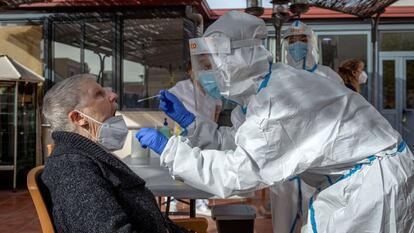Spanish coronavirus vaccination drive to prioritize care home residents
Health Minister Salvador Illa confirms that immunization will be free, voluntary and administered through the public healthcare system

The residents of senior homes and of centers for people with disabilities, as well as their caregivers, will be prioritized in Spain’s coronavirus vaccination drive. The announcement was made on Tuesday by Health Minister Salvador Illa following a Cabinet meeting that approved the new immunization plan for the Spanish population.
Under the plan, the vaccine will be available free of charge at 13,000 administration points in public healthcare centers across Spain. Prime Minister Pedro Sánchez said last week that “a very substantial part of the Spanish population could be vaccinated with all due guarantees during the first quarter of 2021.” Health authorities are expecting the first doses to arrive in January, after the Spanish medicines regulatory agency, the AEMPS, authorizes the vaccines currently under review.
Under the Health Ministry’s plan, the population has been divided into 18 socio-demograpic groups on the basis of four risk criteria
The plan classifies the population into different priority groups, starting with senior and care home residents. Next in line for vaccination are frontline healthcare workers, followed by other healthcare professionals and care home staff. The fourth group includes people with disabilities who require significant support measures but who are not in care homes.
Around 2.5 million people out of a total population of 47 million are expected to get vaccinated between January and March, if the government’s estimates prove to be accurate.
Under the Health Ministry’s plan, the population has been divided into 18 socio-demograpic groups on the basis of four risk criteria: morbidity and mortality, exposure to the virus, socio-economic impact, and disease transmission. The minister did not reveal which groups come after the first four.
“We will provide that information when the time comes. The most vulnerable people will always go first,” said Illa on Tuesday. “An ethical framework has been established giving precedence to the principles of equality and dignity of rights, need, fairness, the protection of minors and people with disabilities, reciprocity and solidarity.”
Following agreements between the European Union and six pharmaceutical companies (AstraZeneca, Sanofi-GSK, Janssen, BioNTech-Pfizer, CureVac and Moderna), Spain is slated to receive 140 million doses of coronavirus vaccines. Because most of these are double-dose, it will be enough for 80 million people, almost twice the population of Spain. The excess doses are meant as a reserve, to encourage production, and to help developing countries.
But the January-to-March window for the first period of the immunization campaign depends on whether the vaccines receive final approval by health regulatory agencies. If so, the second period would span to June and probably target at-risk groups such as older adults and people with underlying conditions. The rest of the population would have to wait until later, although the ministry did not provide details.
The coronavirus vaccine will be the 15th one on the Spanish vaccination calendar. Like all the others, it will be recommended but not mandatory. “It is just as safe as all the rest,” said Illa, who said he trusted in Spaniards’ sense of solidarity to make sure the vaccination drive reaches most of the population, despite polls suggesting that a significant number of people are not willing to get immediately vaccinated. “Results will be better if the vaccine is voluntary,” said Illa.
Coronavirus figures have experienced a slight improvement in Spain. In the last two weeks, new coronavirus cases reported by regional health authorities have dropped from 52,386 to 25,886, according to the Health Ministry. And the 14-day cumulative number of cases per 100,000 inhabitants, a key indicator of the progress of the coronavirus, has fallen by 20% from 460.26 to 374.52 in a week.
English version by Susana Urra.
Tu suscripción se está usando en otro dispositivo
¿Quieres añadir otro usuario a tu suscripción?
Si continúas leyendo en este dispositivo, no se podrá leer en el otro.
FlechaTu suscripción se está usando en otro dispositivo y solo puedes acceder a EL PAÍS desde un dispositivo a la vez.
Si quieres compartir tu cuenta, cambia tu suscripción a la modalidad Premium, así podrás añadir otro usuario. Cada uno accederá con su propia cuenta de email, lo que os permitirá personalizar vuestra experiencia en EL PAÍS.
¿Tienes una suscripción de empresa? Accede aquí para contratar más cuentas.
En el caso de no saber quién está usando tu cuenta, te recomendamos cambiar tu contraseña aquí.
Si decides continuar compartiendo tu cuenta, este mensaje se mostrará en tu dispositivo y en el de la otra persona que está usando tu cuenta de forma indefinida, afectando a tu experiencia de lectura. Puedes consultar aquí los términos y condiciones de la suscripción digital.
More information
Últimas noticias
Most viewed
- Reinhard Genzel, Nobel laureate in physics: ‘One-minute videos will never give you the truth’
- Oona Chaplin: ‘I told James Cameron that I was living in a treehouse and starting a permaculture project with a friend’
- Pablo Escobar’s hippos: A serious environmental problem, 40 years on
- Charles Dubouloz, mountaineering star, retires at 36 with a farewell tour inspired by Walter Bonatti
- Why we lost the habit of sleeping in two segments and how that changed our sense of time










































